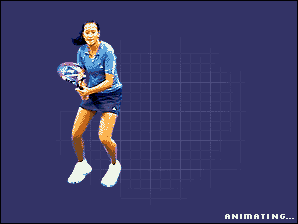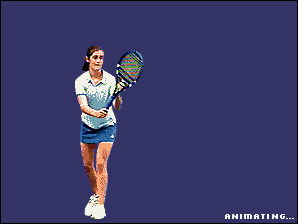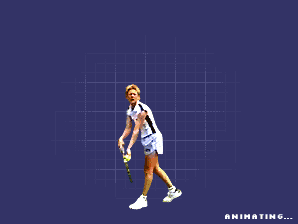Types of Tennis Shots
Once you’ve got your grip and your stance down, there are various shots every tennis player must learn to effectively play the game of tennis. The more you learn and practice these common shots, the tighter your tennis game will be.
.
To be an efficient and effective tennis player, you must learn a certain set of shots and the best time to use them. During a match, every player must make split-second decisions on which tennis shot will be the most beneficial for winning the point—a decision that often comes down to positioning and timing. Here’s a list of the different types of shots you can execute on the tennis court.
- Forehand: The tennis forehand is the most basic shot that every player must have in their arsenal. The forehand stroke is usually the first groundstroke all tennis players learn. Your main shot is hit across the body with your dominant hand (or in some cases, the preferred hand), traveling low to high with the follow-through over your shoulder. Once you have your grip, your forehand groundstroke is either hit with one hand or two hands. However, its advantage lies in its reach—you can stretch farther with your racket to retrieve balls with a one-handed forehand than you can with two hands (though a two-handed forehand can sometimes give you more power). A topspin forehand is usually a player’s most reliable weapon in a tennis match.
- Backhand: The backhand groundstroke is the second tennis stroke most players will learn after the forehand. Since the backhand stroke plays on the non-dominant side (left side for right-handed players and right side for lefties), players usually use both hands for this shot, with the dominant hand on the bottom of the grip, and the nondominant hand above it. While a one-handed backhand offers more reach, a two-handed grip provides more advantages like stability, topspin, and control.
- Serve: The serve is one of the most important shots of the game. A tennis serve starts off every point in the game, and can be hit with varying degrees of spin or slice to help the server gain an advantage. The first serve is often a powerful technical shot to set up the point. The better your serve, the weaker your opponent’s return will be. Most players use a serve to try and ace (win the point on a service without the other player making contact with the ball), or catch your opponent on the defensive. The second serve is for when the server faults on the first attempt—they either step over the baseline, hit the ball out or hit it into the net. Since servers only get two tries per point (unless they hit a “let”), failing to make the serve a second time will lead to a double fault and loss of the point. Both the first and second serves must travel cross-court and land diagonally within the opponent’s opposite service box to count as in play.
- Volley: Forehand volleys and backhand volleys are when the player returns the ball before it bounces, and usually performs right up at the net or half-court. Volleys are aggressive—they’re meant to run your opponent ragged or interrupt the rally’s timing, giving you a chance to catch them off guard or instantly win the point. Since you are positioned much closer to the net, volleys require impeccable timing. You must keep your racket up and block the ball in front of your body as quickly as possible, which means there is no time for a wind-up or backswing. However, coming up to the net leaves the volleying player vulnerable to passing shots or deep lobs, the latter of which can ruin their advantage by sending them scrambling back to the baseline to regain control of the point again.
- Half-volley: The half-volley’s timing is even more difficult than a regular volley. A half-volley occurs when a player hits the ball off the ground at the same time it meets it, resulting in hitting the ball while it’s “on the rise.” Unlike a traditional volley, where the ball is hit out of the air, the half-volley is more of a “pick-up” shot—it requires compact movement and the right positioning to execute correctly.
- Lob: Lobs are high, defensive shots that can help reset the pacing of a point. Lobs arc high over the net and can be performed with groundstrokes or volleys. This shot is especially useful if you have an opponent who is dragging you side to side across the tennis court—you can hit the ball up high into the air, giving yourself an extra second or two to reposition. It is also useful when your opponent rushes to the net, and you don’t want to feed them an easy volley.
- Overhead smash: Overhead shots are how most players deal with lobs. Overheads use the same motion as a tennis serve, and usually occur at the net (however, if the ball is high enough, you can hit one from the baseline). The overhead is a powerful smash technique where players whip the racket in a downwards motion to win the point, or drag the opponent off-court to set themselves up for an easier win.
- Slice: A tennis slice is a tricky shot to master, but can come in handy when you need to slow down a point or change the tennis ball’s bounce. A slice shot uses backspin or sidespin to undercut the tennis ball, which removes topspin, causing the ball to sit lower on the court. The opponent must crouch down and stretch to retrieve a sliced ball, making it difficult to return with power.
- Drop shot: A drop shot is a trick shot that gently drops the ball right over the net, forcing the opponent to sprint forward to return it before it bounces twice. A drop shot is hit softly, and is most effective during an intense, deep baseline rally. Drop shots can catch your opponent off guard by suddenly changing the pace and direction of the point. The aim is to hit it so gently and close to the net that the ball bounces twice before your opponent has time to reach it.
- Passing shot: A passing shot is when one player rushes to the net to try, and volley, but the opposing player at the baseline performs a groundstroke that passes the net player on either side just out of their reach. The passing shot is a critical shot to master if you aren’t confident in your lobs or playing against an especially aggressive net player.
Backhand Volley
Backhand
Forehand
Power Serve
Ready Position
Service
Slice Serve








